Intro
The end of a dynasty
The Valois dynasty came to power in 1328 with Philip VI, this change of dynasty having triggered the Hundred Years War. We are now in 1547, after the death of François I, this article describes the reigns of Henri II and his wife Catherine de Médicis as well as their three sons:François II, Charles IX and Henri III who died tragically while remaining without heirs. Their reigns were strongly marked by the wars of religion between Catholics and Protestants.
Genealogy of the last Valois
Despite the imminent extinction of the Valois branch, the couple Henri II and Catherine de Médicis had had ten children, with among the most famous:
- François, King of France under the name of François II
- Elisabeth of France , wife of King Philip II of Spain (son of Charles V)
- Charles, King of France as Charles IX
- Henri, Duke of Anjou, King of Poland then King of France under the name of Henri III
- Daisy of Valois , nicknamed "Queen Margot", wife of the future Henri IV
- Francis of France, Duke of Alençon , the rebel prince
Genealogy of the last Valois

The reign of Henry II
Youth and accession to the throne
Henri II is the second son of François Ier. His childhood was marked by four years as a hostage at the Spanish court. Indeed, in application of the Treaty of Madrid (1525), François I, who was then the hostage of Charles Quint, left his two sons in captivity. For the young Henri, this traumatic experience will mark him forever, he who is described as taciturn in nature has also become a hypochondriac. In 1533, he married Catherine de' Medici, the daughter of the Florentine prince Lorenzo II de' Medici. Then, he becomes the heir to the crown following the mysterious death of his older brother François de France. He then took part in his father's campaigns against Charles Quint in 1542. In 1547, he came to power on the death of François I. He then hastened to change the Court by driving out his father's former advisers. Among the relatives of the new king, there are in particular:the constable Anne de Montmorency, Jacques d'Albon de Saint-André, as well as the Lorraine princes:François de Guise and his brother Charles de Lorraine.
The King's Emblem
Like many Renaissance sovereigns, Henry II adopted an emblem found on the architecture of the time (Loire castles in particular). If François I had chosen the salamander, Henri chose the crescent moon, symbol of the house of Orléans, and the following motto:"The emulator of the sun is full, until it fills the world integer" .
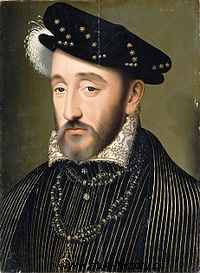
Henry II, by François CLOUET (1559)
Events of the reign of Henry II
The reign of Henri II is part of the continuity of the political and artistic work of his father. The king continues the Italian wars and focuses his attention on the empire of Charles V.
- Henry II negotiates with the German princes who fight against Charles V (Treaty of Chambord, 1552). The princes obtain the support of the king of France by yielding at the same time the control of the "Three Bishoprics" (Metz, Toul and Verdun). Charles V, who subsequently besieged the city of Metz with 60,000 men, was brilliantly repelled by the Duke of Guise, François.
- Against England, Henri II bought Boulogne-sur-Mer while François de Guise took over the city of Calais, the last English possession in the territory.
- In Italy, against the Imperials (Habsburg), the Duke of Guise again, however, had less luck during an expedition to Naples. Henry II is forced to abandon the French claims to the Kingdom of Naples and the Duchy of Milan. It is the end of the Italian wars initiated by Charles VIII.
- The conflict against the Habsburgs continues after the death of Charles V with his son Philip II of Spain. In 1557, following the disastrous defeat of Saint-Quentin (the Constable Montmorency was captured there), Henry II was forced to accept the peace treaty of Cateau-Cambrésis and gave his daughter Elisabeth to the King of Spain.
- Finally, in domestic policy, to consolidate the unity of the kingdom of France, Henry II decided to eradicate the Huguenots. The edicts of Châteaubriant (1551) and Écouen (1559) sentenced Protestants practicing their religion to death.
Jarnac's coup
The King's Court is the subject of a rivalry between two very influential women, their bickering will finally trigger the duel of two men:
- François de Vivonne, lord of La Châtaigneraie (camp represented by Diane de Poitiers, mistress of Henry II)
- Guy Chabot, future Baron de Jarnac (camp represented by Anne de Pisseleu, Duchess of Etampes and mistress of François I).
The duel was pronounced on the accession of Henry II in 1547. A great fencer, La Châtaigneraie seemed to take the advantage when Chabot suddenly pulled off a secret trick:a backhand blow that split his opponent's knee. Humiliated by his defeat, La Châtaignerie removed his bandages and died of his wounds. Guy Chabot was also killed in another duel. The "Jarnac blow" entered the language, designating a treacherous blow, in a completely unexpected way.
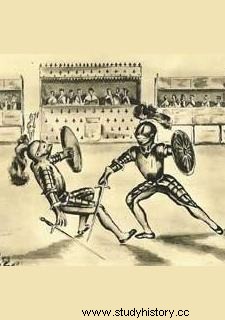
The tragic death of the sovereign
On the diplomatic level, Henry II negotiates the marriage of two of his children.
- His eldest son François is promised to Mary Stuart, Queen of Scotland and niece of the powerful François de Guise. The young girl was taken to France at the age of six to be brought up near her future husband. This episode marks a break with the English who hoped to unify the crowns of England and Scotland. Mary Stuart was later imprisoned by her cousin Queen Elizabeth and later executed for treason.
- His daughter Elisabeth is given as wife to Philip II of Spain, son of Charles Quint. On the occasion of the wedding, the king who is considered the last "knight-king" decides to participate in the festive tournaments that take place on rue Saint-Antoine in Paris. On June 30, after defeating the Dukes of Nemours and Guise, Henri confronts the captain of the Scottish Guard, Gabriel de Montgommery. This one wounds him with a splinter of a spear in the eye. Despite the care of the royal surgeon Ambroise Paré (who reproduced the wound on convicts to treat it better), the king died on July 10, 1559 after ten days of agony. Queen Catherine will mourn until her death.
The prediction of Nostradamus
Michel de Nostredame dit Nostradamus (1503 - 1566) is a French apothecary known for his esoteric predictions. His most famous prophecy seems to announce the death of King Henry II with this quatrain:
The young Lyon will overcome the old,
In a warlike field through a singular duel,
In a golden cage the eyes will hollow him out,
Two classes come, then die, a cruel death.
During the tournament, Henry II and Montgommery both wore the lion badge. And the king's helmet was according to some made of gold (golden cage).
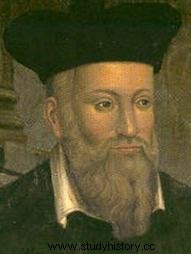
The reign of Francis II
The advent of the Guises
On the death of his father, the young King François II was fifteen years old, and he was in very fragile health. He therefore left the reins of power to his wife's uncles:the Guise. This great noble family was then at its peak, its two representatives shared power:
- Duke Francis (known as Le Balafré), a renowned military leader under Henry II, took command of the royal army. He is a devout Catholic.
- His brother Charles, Cardinal of Lorraine , is the true political head of the family. He takes charge of justice, diplomacy and finances.
The advent of the Guises drives out the old favorites of the previous reign from the Court:
- the Constable of Montmorency , the great rival of the Guise family, warrior and friend of Kings François I and Henri II, he took part in the battle of Marignan. He remains a great figure of the French Renaissance.
- The favorite of King Henry II, Diane de Poitiers , very influential on the latter. Jealous, Queen Catherine had chased him away from the king's funeral.
Diane de Poitiers, favorite of King Henry II
The whore of the king as Queen Catherine de Medici called her was twenty years older than Henry II. She exerted a great influence on the king who dedicated her a sincere love. She resided at the Château de Chenonceau before recovering the Château de Chaumont on the king's death.
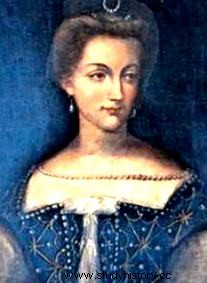
The Amboise Conspiracy
The Guise are very quickly unpopular, lacking legitimacy, they do not hesitate to carry out a repressive policy with Protestants. A group of gentlemen then set up the project to overthrow them, in order to promote the seizure of power by the princes of the blood who had rallied to the new religion:Antoine de Bourbon and his brother the Prince of Condé. The latter wish to seize the young François II who has been transferred to the castle of Amboise. But the rebellion is a failure, the Duke of Guise and the Duke of Nemours quickly put an end to it by chasing the rebels, who are cruelly massacred. The Prince of Condé, designated as the beneficiary of the conspiracy, manages to escape after playing a double game. The royal council under the influence of Catherine de Médicis then proposes a series of concessions by promulgating a general amnesty to Protestants. The humanist Michel de l'Hospital is appointed by the Queen Chancellor of France. But this policy of conciliation is a failure, and it causes the fire in the province. Encouraged, the Protestants multiply the riots and the sermons. Several towns then entered into a state of insurrection. The reign of François II is also marked by the decline of French domination in favor of Spain. Covered with debts following the conflicts with the Habsburgs, France evacuates Scotland, Brazil, Corsica, Tuscany, Savoy and the majority of Piedmont. Francis II dies after only seventeen months of reign, after unbearable pain in the ear.
François de Lorraine, Duke of Guise
A childhood companion of King Henry II, François de Guise was a great warlord. Like his later son, he is nicknamed "Le Balafré" in memory of a facial scar received at the siege of Boulogne.
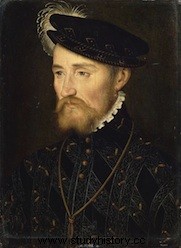
François de Guise, by François CLOUET (Louvre Museum, Paris)
The major offices of the Crown
- Constable :Sovereign Chief of the Armies of France (Montmorency)
- Lieutenant General of the Kingdom :In times of crisis, person entitled to exercise all or part of royal authority (Duke of Guise then Duke of Anjou)
- Chancellor :Responsible for sealing and dispatching royal acts, then Head of Justice. Substituted by the Keeper of the Seals (Michel de l'Hospital)
- Grand Master of France :Head of the king's household for its civil part (dukes of Montmorency then dukes of Guise)
- Admiral of France :Responsible for maritime affairs (Gaspard II de Coligny then Charles de Lorraine)
- Marshal of France :Military dignitaries (Montmorency father and son, Jacques d'Albon de Saint-André)
The reign of Charles IX
The Regency of Catherine de Medici
When his brother died, Charles was only ten years old. Having received a remarkable education, attentive to the teaching of the humanists, Charles IX could not escape the tutelage of his entourage. Through him, his mother Catherine de Medici continued to govern France with the concern to preserve the monarchical authority and the unity of religion. “It was she who did everything, writes a witness at the time, and the Roy did not turn an egg until she was informed”. Surrounded by Italian advisers, this Florentine of illustrious birth, whose political activity was incessant after the death of Henry II, tried somehow to appease the troubles of the kingdom. The religious divide was indeed much politicized at the end of the reign of Henry II. But the religious wars will really begin under the reign of Charles IX. During the minority of the young king, Chancellor Michel de l'Hospital tried to bring Catholics and Protestants to a compromise:he published in January 1562, the edict of Saint-Germain-en-Laye which granted freedom of worship to the Reformed and aims to organize coexistence between divided Christians. The response of the Catholic extremists was not long in coming:a month later, in Wassy, in Champagne, the people of the Duke of Guise's escort massacred Protestants celebrating their worship. Thus was triggered the first of the Wars of Religion. There will be eight in total.
Religious clans
Catholics
- The Dukes of Guise :
- François de Guise, the most illustrious, great military leader under Henry II.
- Charles de Guise, brother of François, Cardinal of Lorraine and Duke of Mayenne.
- Henri de Guise, son of François, the head of the Catholic League.
- The Royal Family is Catholic, however, Queen Catherine de' Medici is more measured and seeks to appease the kingdom's troubles. Henri, the Duke of Anjou is the lieutenant general of the kingdom.
- A "Catholic Triumvirate" brought together for a time the greatest Catholic personalities:François de Guise, Anne de Montmorency, Jacques d'Albon de Saint André.
- Spain of King Philip II is external support for the Catholic camp.
Protestants
- Princes de sang (descendants of Saint Louis):
- Bourbon :Antoine de Bourbon, king of Navarre then his son Henri de Navarre are more concerned with politics, they will both change their religion several times.
- Condé :Louis de Bourbon, Prince of Condé (brother of Antoine de Bourbon), then his son Henri de Condé. The Condés are ambitious and active characters, they are great Protestant leaders.
- The Montmorency , unlike their father, the sons of the constable Anne de Montmorency are Calvinists, they go hand in hand with their cousin Admiral Gaspard de Coligny , leader of the Huguenot camp until Saint-Barthélemy.
- Montgommery , the involuntary regicide of King Henry II, a refugee in England, will seek to intervene in Normandy before being captured and executed.
- England reformed by Elizabeth I and William of Orange of the United Provinces (Netherlands) are the foreign supporters of the Huguenots.
The first religious conflicts
- First religious war (1562-1563) :The first religious war which broke out following the massacre of Protestants at Wassy saw the death of Antoine de Bourbon (siege of Rouen) and François de Guise (siege of Orléans). Queen Catherine negotiates peace with the Prince of Condé by the Edict of Amboise (1563). Protestant worship is now permitted in some places.
- Second Religious War (1567-1568) :Resumption of hostilities four years later. Queen Catherine abandons her policy of conciliation, Michel de l'Hospital is disgraced in 1567. The Protestants commanded by the Prince of Condé and Gaspard de Coligny are at the gates of Paris. They were finally defeated by the Constable de Montmorency and peace was signed at Longjumeau in 1568.
- Third Religious War (1568-1570) :The war resumes after a few months. The Catholics try to capture the Protestant leaders:the Prince of Condé and Admiral Coligny who are locked up in "La Rochelle", the stronghold of the Protestants. The Prince of Condé is killed and the royal army, led by Henri d'Anjou, takes the advantage before Coligny manages to impose the signing of a truce, the Edict of Saint-Germain (1570).
Catherine de Medici
An emblematic figure of the 16th century, Catherine de Medici is directly linked to the wars of religion, but also to her patronage activity. She protected many artists and largely contributed to the development of art in the service of the monarchy. Modern historians see her as one of France's greatest queens, but her image is sharply contrasted by her murky role in Saint Barthélemy.
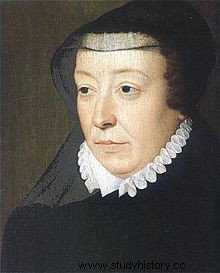
The Saint Bartholomew's Day Massacre
In the heat of the summer of 1572, the Parisians witnessed the preparations for the wedding of Marguerite de Valois and a "heretic rebel against her king", the Protestant Henri de Navarre (prince of the blood and future Henri IV). Preachers roam the streets, chanting threats. For ten years, Parisians have been subject to the same discourse:the true religion is Catholicism, the only faith is that of the king. The atmosphere is particularly heavy, and the city, invaded by hundreds of Protestants who have come for the wedding, is a real powder keg. However, there are no major incidents during this day of August 18, nor during the three days that follow:the shimmering clothes of good Catholic society contrast with the dark clothes of Protestant gentlemen. But the preachers continue to push the people to revolt:Catherine de Medici, mother of King Charles IX is an ally for them. She had already tried, without success, to have the leader of the Protestants, Admiral de Coligny, assassinated. This time, his plan is put into execution on the night of August 23 to 24. Coligny was killed with a dagger and then his body was thrown out the window. The conspirators then closed the bridges over the Seine and, hiding the boats to prevent any escape, they headed for the Louvre, where most of the Protestant gentlemen present in Paris were staying, and massacred them. At dawn on August 24, the people of Paris, mostly Catholic, entered the scene:guided by the ambient tension and the fear of the other, 2,000 to 3,000 Protestants, or supposed to be such, were killed.
The St. Bartholomew's Day Massacre
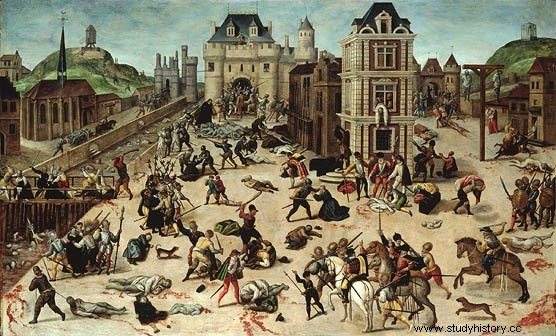
The Saint-Barthélemy massacre, by François DUBOIS
Who is the instigator of Saint-Barthélemy?
Some controversies now exist on the responsibility for the assassination of the Protestant leaders. The day before his death, Admiral de Coligny had already suffered a first assassination attempt, several hypotheses have been formulated:
- The official version accuses Queen Catherine de Medici and her entourage who were worried about Coligny's influence on her son. These words have been attributed to Charles IX, freshly convinced by his mother and his advisers:“Well be it! Let's kill them! But kill them all! Let there not be one left to reproach me for it! » . In the past, it has been said that the young sovereign fired on Protestants from his window in the Louvre.
- Henri d'Anjou, the king's brother is also under suspicion. Having become lieutenant general of the kingdom, it was perhaps a good opportunity for him to impose himself on the government. He could have received the support of Henri de Guise.
- The Duke of Guise may have plotted with the support of Philip II of Spain. Indeed, Admiral de Coligny was planning to make war on Catholic Spain.
- Fourth War of Religion (1572-1573) :The Saint-Barthélemy massacre leads to a fourth religious war in October 1572. The Protestants are isolated, Henri de Navarre and the new prince of Condé (Henri) are now converted to Catholicism. However, the royal army fails during the siege of La Rochelle. The Duke of Anjou was named King of Poland, peace was signed in 1573. King Charles IX then found himself increasingly isolated.
The Conspiracy of the Malcontents
After the conspiracy of Amboise under François II, the reign of Charles IX was also the subject of a new revolt:the conspiracy of the Malcontents. The Malcontents refer to the few people who are in the shadow of the Queen Mother's power:
- The young ** François d'Alençon **, last son of Henri II, who grew up in the shadow of his brothers, in particular Henri, Duke of Anjou who was named King of Poland. He hopes to overthrow his mother's government and become heir to the kingdom in place of his brother Henry. He becomes the hope of the rebellious nobility.
- The Duke François de Montmorency , son of the Constable Anne de Montmorency, who retired from the Court on his estates in Chantilly.
- The Blood Princes, Henry of Navarre and his cousin ** Henri de Bourbon-Condé**. They recanted Protestantism and were placed under house arrest at court. Condé is the great rival of Henri d'Anjou, who had his father assassinated at the battle of Jarnac and who covets his wife Marie de Clèves.
Following an assassination attempt on Duke Henri de Guise, which could be mandated by the Malcontents, François d'Alençon and Henri de Navarre were forced to flee the Court. From there, they foment two plots, with the help of accomplices who fail. The reaction of the queen mother is virulent, the accomplices are arrested and executed. Henri de Navarre and François d'Alençon are interrogated. This revolt triggered the fifth war of Religion (1574-1576) while King Charles IX succumbed to tuberculosis.
Ronsard and the Pleiade
A lover of poetry, Charles IX had invited the poet Ronsard to reside at the Cour du Louvre. The king notably asked him to write "La Franciade", an epic poem on the origins of France. Pierre de Ronsard is one of the most important poets of the 16th century, he is the leader of La Pléiade, a literary movement responsible for promoting the French language. In the tumult of religious wars, Ronsard distinguished himself from other artists by condemning Protestantism.
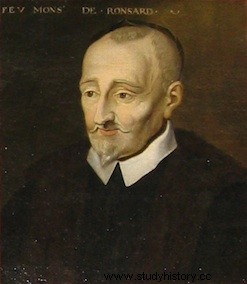
Portrait of Pierre de Ronsard, oil on canvas, Museum of Fine Arts, Blois
The reign of Henry III
The accession of Henry III
Henri, his mother Catherine's favorite son, who had been named King of Poland, returned to France when his brother's death was announced. He takes care to circumvent Protestant Germany. The kingdom of France was then in a disastrous state, bathed in major economic, social and religious troubles.
- Fifth Religious War (1574-1576) :The plot of the Malcontents led by François d'Alençon, and the Montmorencys relaunched the war. On the death of Charles IX, Henri III leads a campaign in the South. The Prince of Condé returned to Protestantism, while Henri de Navarre fled from the Court. The Protestants surround Paris, the king must bow and grant the Edict of Beaulieu (1576) with freedom of worship in the closed cities and Paris. It's peace of sir (a term designating the king's brother) who then reinforced his rebellious brother, François d'Alençon.
- Sixth Religious War (May 1577 - September 1577) :The Catholics, who find that the provisions of the peace are excessive, meet in local leagues. The king is reconciled with his brother and leads a new campaign in Languedoc with the siege of Montpellier. A new edict is signed, restricting Protestant worship.
- Seventh Religious War (1579-1580) :Catherine de Medici undertakes to establish a definitive peace. But the royal authority is diminishing, the parties are too strong, the provinces are controlled by the Guise for the Catholics, and Navarre and Condé for the Protestants.
Luxury at Court
In addition to the horrors of war, the reign of Henry III was marked by the development of elegance at court.
- Henry III is an elegant and refined man, he made doublets with a bump in the stomach and pipe collars fashionable. The king covered himself with all kinds of jewelry:earrings, necklaces, rings and he flooded himself with very fragrant perfumes (civet, musk, etc.).
- In court costume, the men sported baggy velvet trousers cut at the knees, matching velvet pumps and silk stockings; their shoulders were covered with a small cape and their head was covered with a hat with a feather.
- The ladies costume was characterized by narrow pointed bodices held by blades of ivory or metal which penetrated the flesh; the sleeves and shoulders were padded with cotton and puffed up. Large ruffs enveloped the head like a halo, and an extravagant hairstyle with hair raised and drawn by metal wires framed a face hidden by a velvet mask.
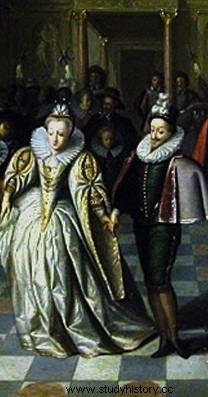
Ball of the Duke of Joyeuse, circa 1582, Franco-Flemish School, (Paris, Louvre Museum)
The war of the three “Henri”
From now on, the religious conflict pits three Henri against each other:
- Henri de Guise (son of François de Guise) at the head of the Catholic extremists of the Holy League.
- Henry of Navarre, heir apparent to the French crown who represents the Protestant party.
- Henri III, the King of France, must find his place between the two parties.
Henri III's Minions
Henri III is the first king of France to surround himself with his favorites (or cutesies), these young effeminate ephebes, in eccentric and grotesque costumes. This sexual ambiguity was used by the League's violent propaganda ("pink legend"). But Henry III is also a ladies' man, and he is credited with many mistresses.
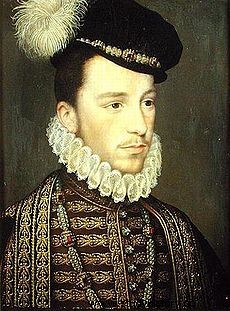
Henri III before his accession by François CLOUET (1570), Condé Museum
-
Eighth Religious War (1585-1598) :On the death of François d'Alençon (tuberculosis), Henri de Navarre becomes the pretender to the throne. Catholics who do not want a Protestant on the throne sign with the Spaniards the Treaty of Joinville which agrees that Cardinal de Bourbon (uncle of Navarre) will be the potential successor of Henry III, still without inheriting. The Duke of Guise, at the head of the Catholic extremists of the League, imposes on the king the hunt for heretics. Soon, Henri III led the war on his own successor, but it was Navarre who took the advantage by crushing the Catholics at the Battle of Coutras (1587). The extent taken by the Catholic League greatly worries the king, who decides to take the lead in an attempt to control it. But the Duc de Guise, who is very popular, makes his triumphal entry into Paris, ridiculing the king. Alerted, Henry III called in the Swiss Guards, thus triggering a general insurrection of the Parisians, it was the day of the barricades (May 12, 1588) . The king is threatened, he flees and takes refuge in Chartres. From there, he decides to convene the Estates General of Blois to raise funds for the war. It was during this assembly that the king had the Duke of Guise and his brother assassinated by his personal guard, the "Quarante-Cinq".
This is where the difficulty lies, following the assassinations, the League cut off all contact with the king. Henri III must ally himself with the Protestants to hope to take back his throne, he meets Henri de Navarre in Plessis-Lès-Tours. The two armies lay siege to Paris, which is protected by 45,000 militiamen supported and armed by the King of Spain. But Henri III will never see his capital again, while waiting at the Château de Saint-Cloud, he is assassinated by the leaguer monk Jacques Clément. Henri de Navarre was then named King of France under the name of Henri IV. This one will have the difficult task of ending the civil war and pacifying France.
The assassination of Henry III
The king is sitting on his commode when he is stabbed by the fanatical monk Jacques Clément:“Wicked monk, you killed me”. He will die after a night of agony.
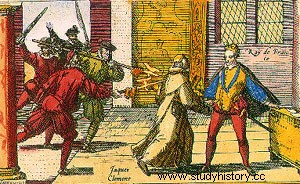
Also read the article "The Reformation" to learn more about the religious antagonisms of the 16th century. The rest of this article will be devoted to Henri IV
